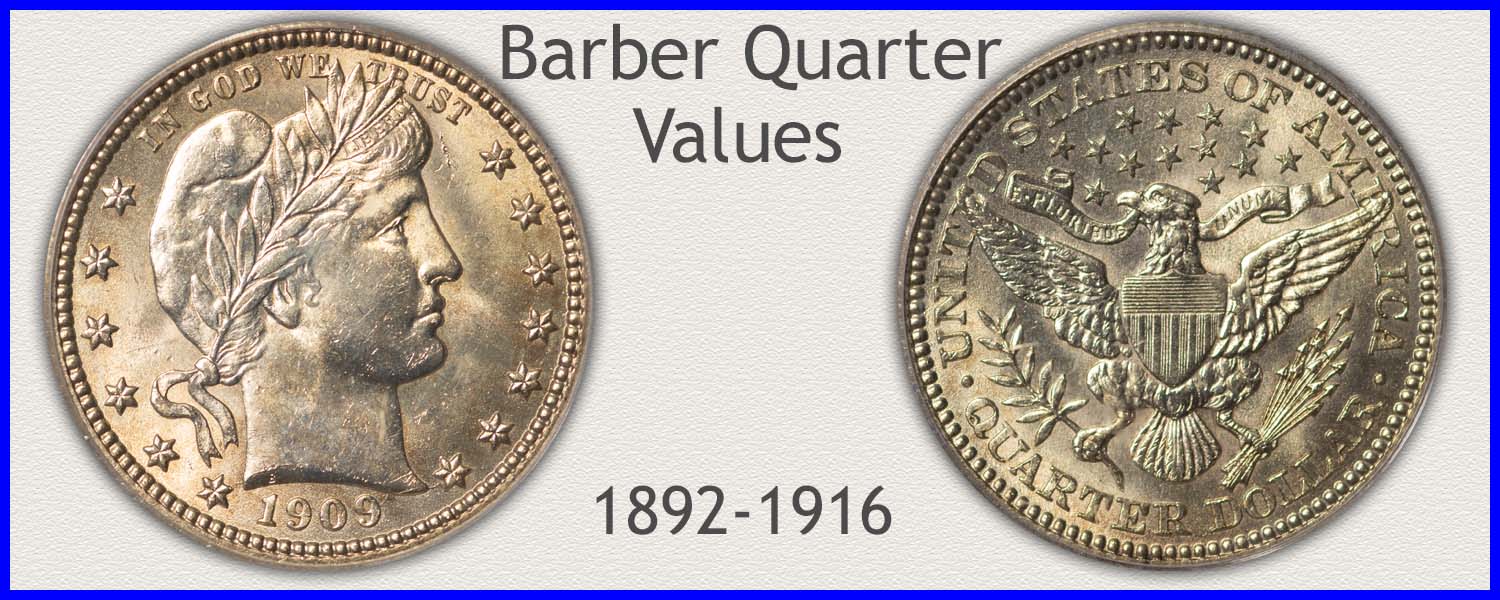Coin Values Moving with Precious Metals: Up-Dated 4/14/2025: Gold $3226 | Silver $31.88
1913 Quarter Value
In order to narrow down 1913 quarter value, collectors and dealers use a defined method.
A few key elements influence how much a Barber quarter is worth. To begin, coin series are collected, described, and valued using date and mint combinations. The second step is to assess each coin's condition and general appeal. Follow the method outlined below to complete the process and locate an accurate listing on the chart.
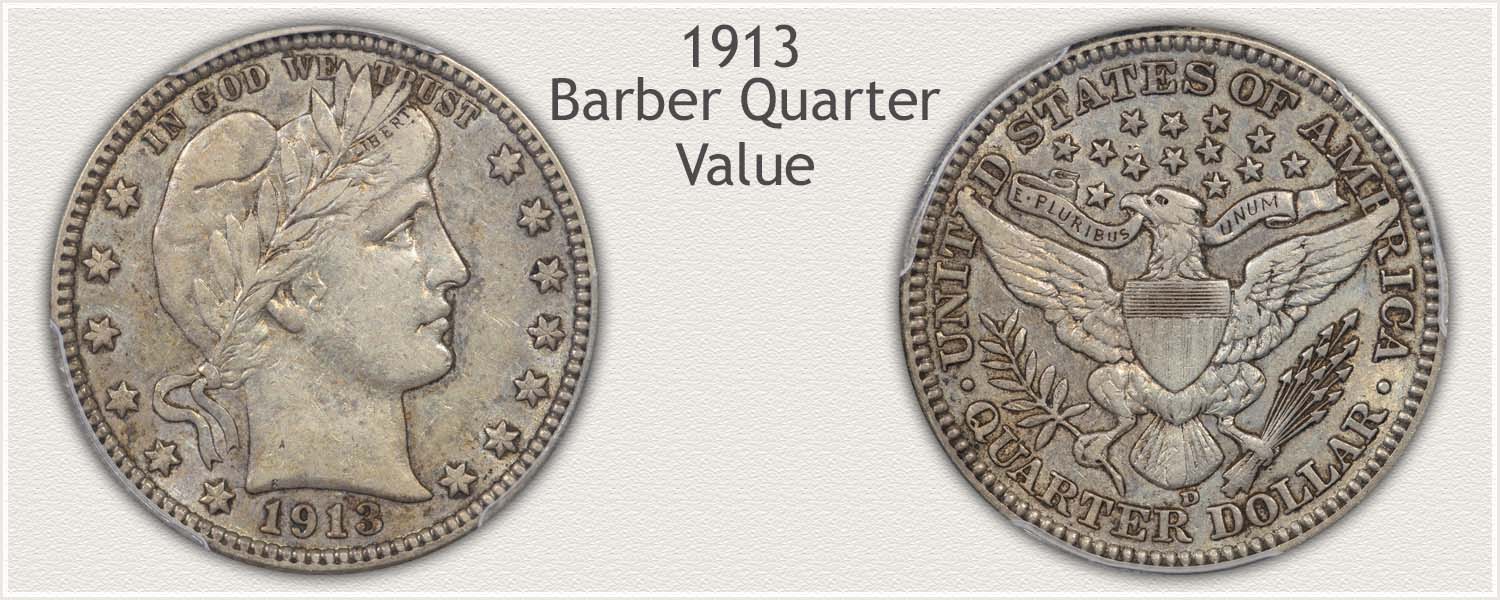
Steps Leading to Value:
- Step 1: Date and Mintmark Variety - These Barber quarters are in demand by collectors, who place a premium on their date and mintmark combinations. To ensure that the mint variety, an inspection is required.
- Step 2: Grading Condition - It is unfortunate that most examples of these quarters remaining today are in very poor condition. Identifying key elements within the design points to higher quality than average.
- Step 3: Special Qualities - A special year in the series, low mintage production and an eye to quality finds premium coins.
| 1913 Quarter Value | ||||
|---|---|---|---|---|
| Condition of Coin | ||||
| Date | Good | Fine | Extremely Fine | Mint State |
| Barber Quarter Values Updated | 4/14/2025 | |||
| 1913 | $28 | $95 | $337 | $459 |
| 1913 D | $10.73 | $49 | $85 | $232 |
| 1913 S | $942 | Rare | Rare | Rare |
The above chart list wholesale 1913 Barber Quarter values. Computed from dealer's price lists and auction records with various mark-up factors figured in.
Step 1: | Scarce Date and Mint Combinations Identified
1913 an Important and Valuable Year in the Barber Quarter Series
Three mints produced quarters in 1913. One mint variety is very rare, another very scarce, and the third enjoys a premium over basic silver content value. These separate mint issues are identified by the mintmarks placed on the coin.
Use the images just below to located the mint issue of your coin. Each of the three varieties are listed separately on the chart.
1913-S Barber Quarter
"S" Mintmark on Reverse: San Francisco Mint Struck the Coin
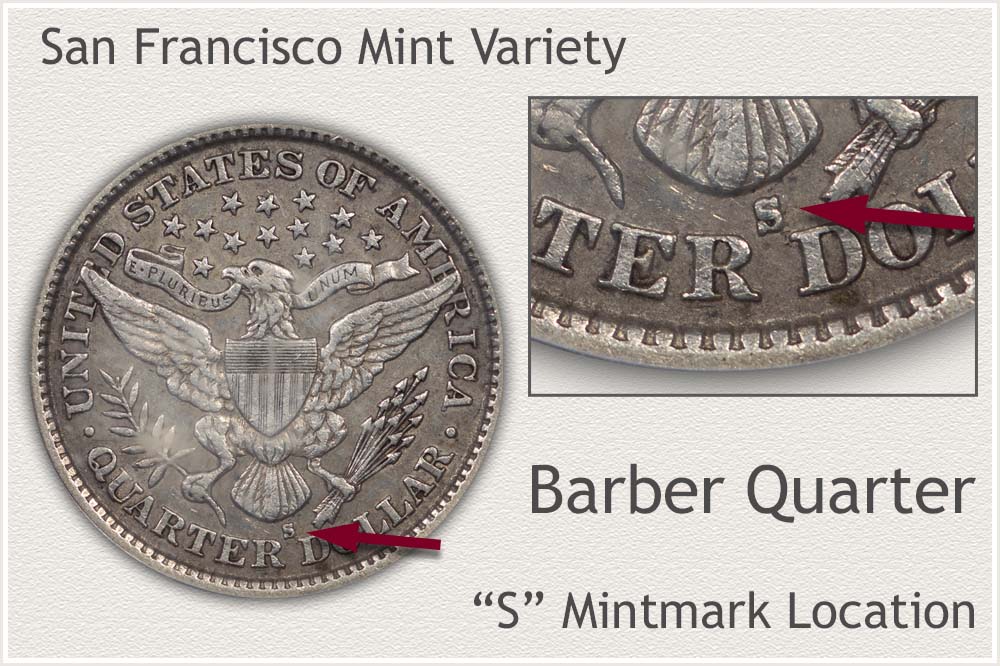
Considered and referred to as a "Key" to the Barber quarter series, 1913 San Francisco quarters are a rarely encountered coin. The San Francisco mint only produced 40,000 quarters for the year, and the number went on to become the lowest mintage of any date and mint variety. Few of these quarters remain, and all are avidly sought by collectors.
The value charts notes these are seldom seen in any condition above heavily worn. With a starting value in the hundreds of dollars, all are inspected closely to judge condition. Auction results provide an insight recording many thousands of dollars is required to obtain one of the few high-grade examples.
Examine the reverse of the quarter. In the area below the eagle's tail feathers and just above "Quarter Dollar" is the mintmark location. A large "S" is the mark of the San Francisco Mint.
1913-D Barber Quarter
"D" Mintmark on Reverse: Denver Mint Struck the Coin
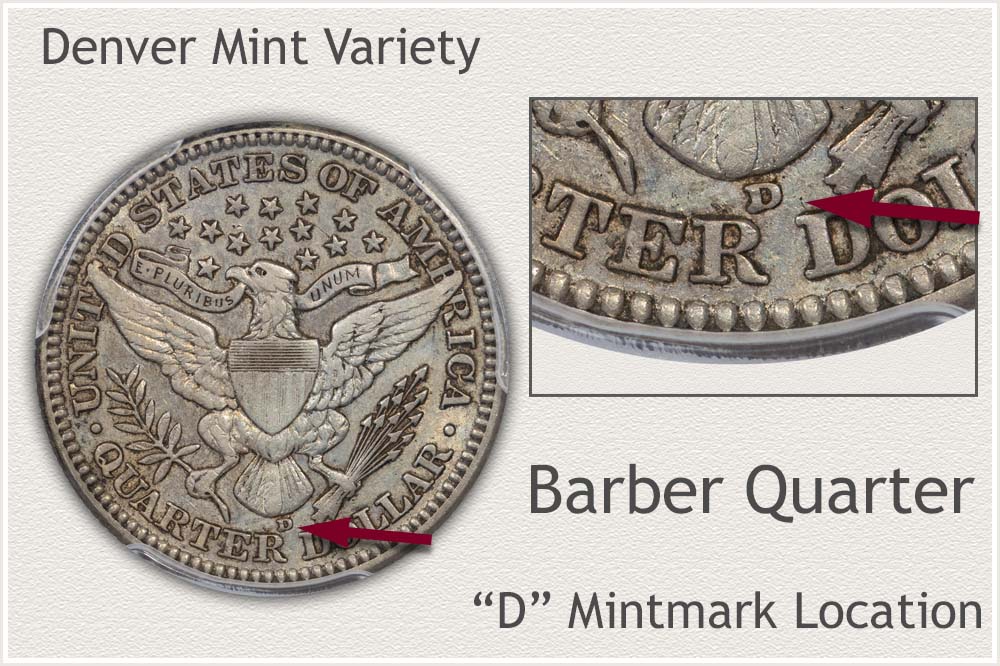
1913 is a difficult year for collectors to find examples of quarters from all mints. Denver, of the three mints striking quarters that year, is the likely encountered variety. With a production of just under 1.5 million these far outnumber the Philadelphia and San Francisco issues. The Denver coinage has become important to represent and Barber quarter from 1913.
Heavily worn examples are worth a small premium above their underlying silver content value. This coin is unfrequently found in higher condition. Denver mint issues are recognized by the "D" mintmark. Examine the reverse of the coin, looking below the tail feathers of the eagle, if the large "D" is present, Denver produced the quarter.
1913 Barber Quarter
No Mintmark on Reverse: Philadelphia Mint Struck the Coin
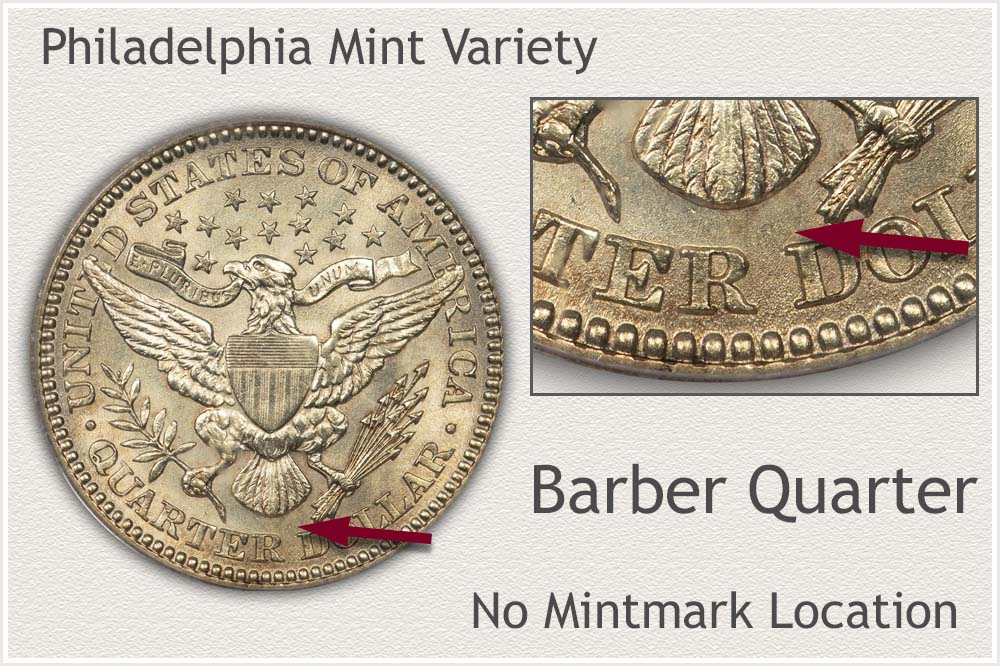
A 1913 Barber quarter became an historical issue of the series. At the completion of the Barber series in 1916, 1913 Philadelphia quarters became the lowest mintage yearly total of the Philadelphia mint. Just over 484 thousand were struck and released into circulation.
This mint variety is a favorite with collectors today, enjoying strong demand. A difficult coin to find in nice condition, all are closely inspected to find a pleasing example to include in a collection.
Philadelphia mint did not place mintmarks on coinage during the Barber series. The reverse of the coin, in the area just above "Quarter Dollar" is empty of any mark. No lettering in this space confirms the Philadelphia variety quarter.
Step 2: | Identify Condition to Define a Grade
Range of 1913 Quarter Value is Narrowed by Judging Condition
Condition of these Barber quarters determines their worth as a collectible. A higher condition and grade is indicated when more of the original design details are still present. In addition to describing and placing a narrow range on the value of coins, grades help define condition.
Magnification helps you see some of the finer details described. Additionally, highlighting the coin's surface by using a single light source creates contrast to small details. Examine a Mint State coin first to see all of the details that were present when these quarters were first produced. As described in the different grades, wear starts with smoothing the highest relief areas, resulting in a lower condition.
Mint State Grade
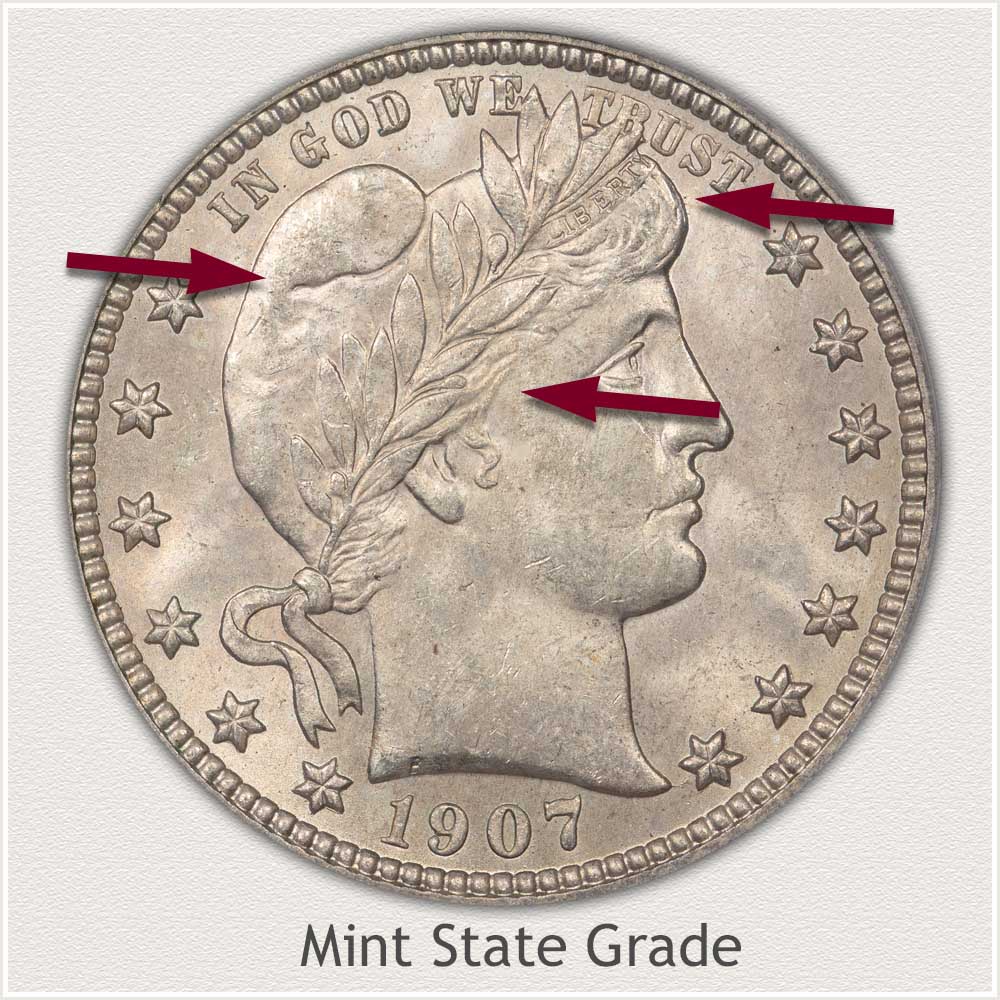
Mint State: Recognizing a Mint State grade Barber quarter is confirming no wear to the surface is visible. On high, small design elements, wear quickly flattens these surfaces. Also, luster, the shine of an undisturbed surface remains full without any smoothing.
On the example quarter, Liberty's hair above her forehead is inspected. There is no flattening of the fine strands of hair, helping indicate no wear to the design. All along the hairline to her ear, the metal remains bright, with no smooth spots or dulling. Wear in this area shows as a dull-grey color.
Open areas of Liberty's cap also remain with a shine of intact luster. Importantly, the fine texture of luster covers the outer edge of the cap. Using a magnifying glass helps recognize these details, as does tilting the coin under a single light source.
Extremely Fine Grade
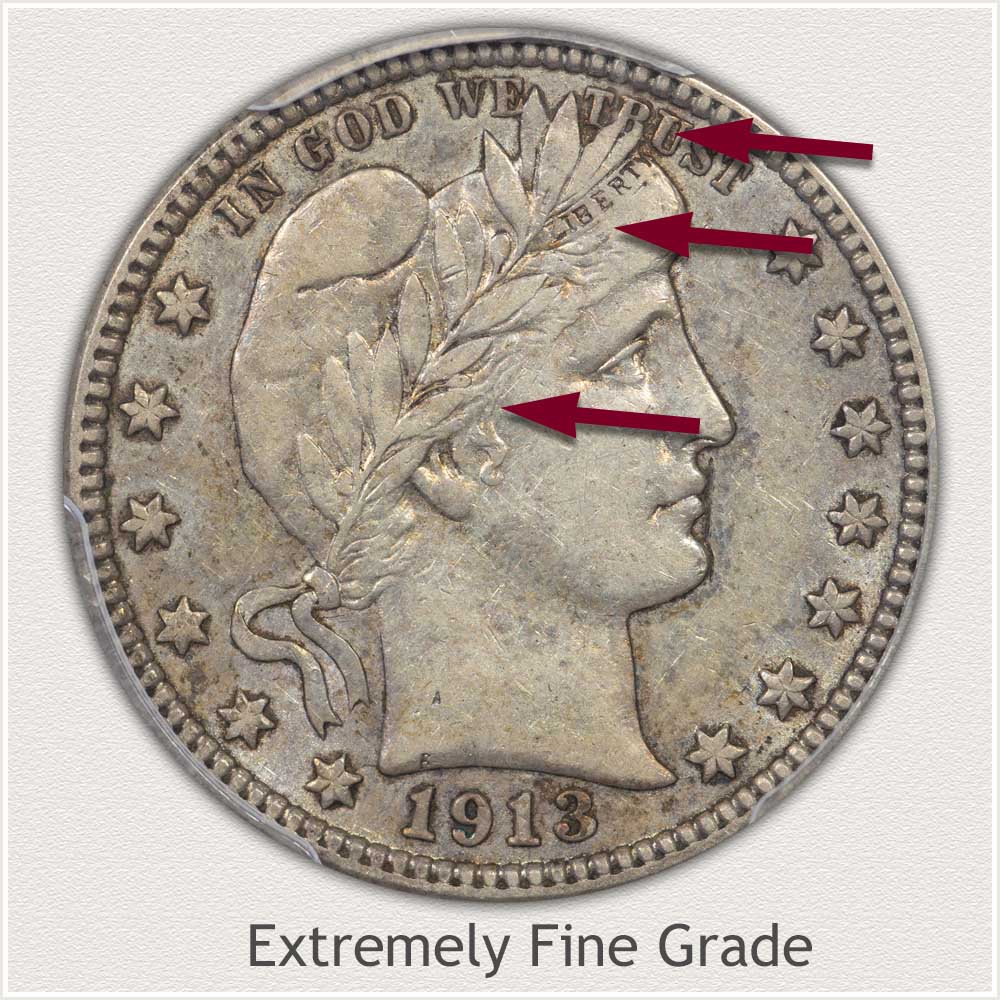
Extremely Fine: Among collectors, a condition of Extremely Fine is highly collectible and appealing. A coin in this condition of preservation shows the majority of its original detail while being only slightly worn. This grade requires a few essential features present, and collectors carefully examine each quarter to ensure its quality.
As part of the design of Liberty's hairband, the word "LIBERTY" is deeply recessed. All letters are required to show for the coin to grade as high as Extremely Fine. In addition, note the band's bottom edge is visible but slightly less defined than the top edge.
Second, when looking closely at the leaves of Liberty's wreath, notice how all of the edges of the top and especially the bottom row of leaves are clearly defined. A high condition quarter is identified by the sharp detail of the leaves and their stems. In general, wear only flattens the very highest points of the design.
Fine Grade
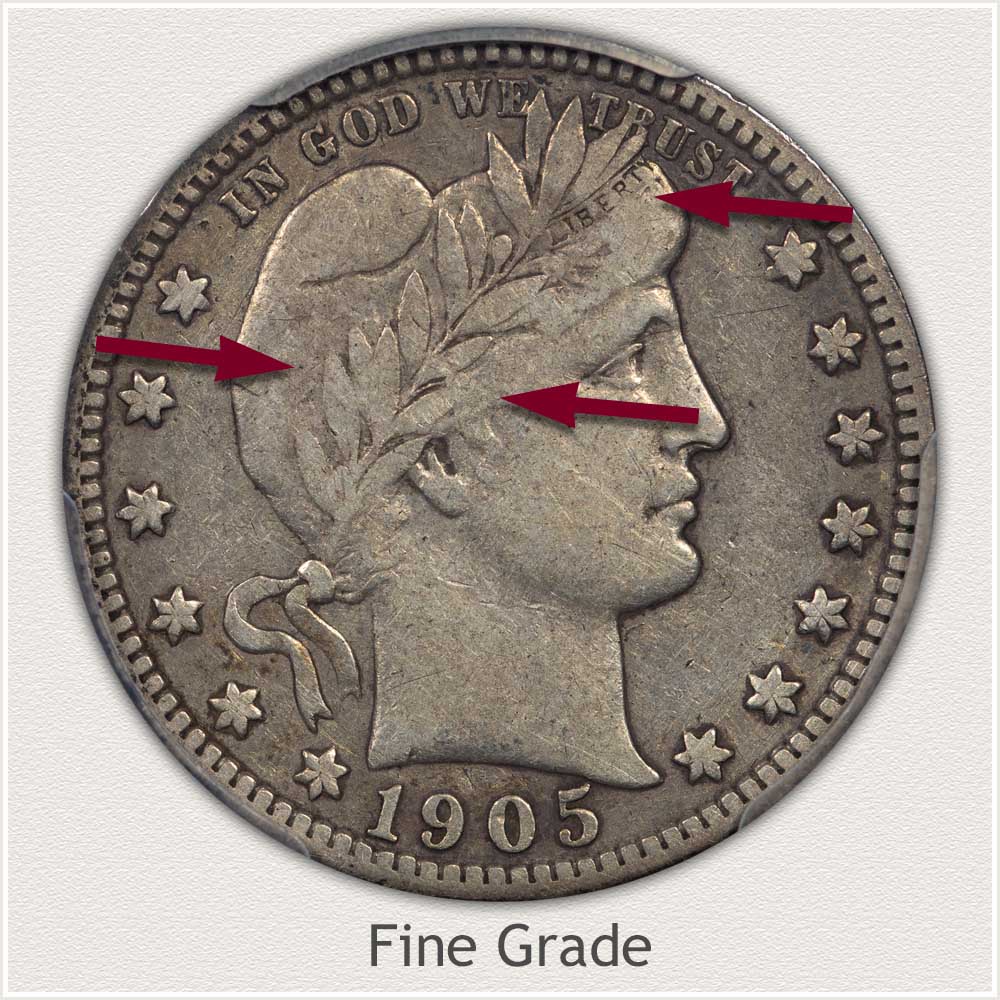
Fine Grade: In Fine condition, wear is moderate, flattening of the metal is minimal, and minor design features have just begun to blend together. Remaining detail within the wreath, the lettering on the headband, and the general flatness of the metal, all contain signs and are evaluated to grade this condition.
Liberty wears a laurel wreath in her hair, symbol of achievement and victory. Although the upper row of leaves is flat and smooth, they are clearly defined from her hair, a requirement to qualify as Fine grade. Lower leaves are a little less clear, and many of them blend into her hair towards the ends.
An important feature is all letters of the word "LIBERTY" are displayed above her forehead. Fine grade quality is determined by a strong "BE" remaining in the center.
Liberty's portrait has only slight flatness to its overall contours. Judging the stars along the rim, note the metal is flat and the central radial lines are gone. However, each star stands out very clearly from the field. These quarters are in a collectible condition with plenty of crisp detail visible.
Good Grade
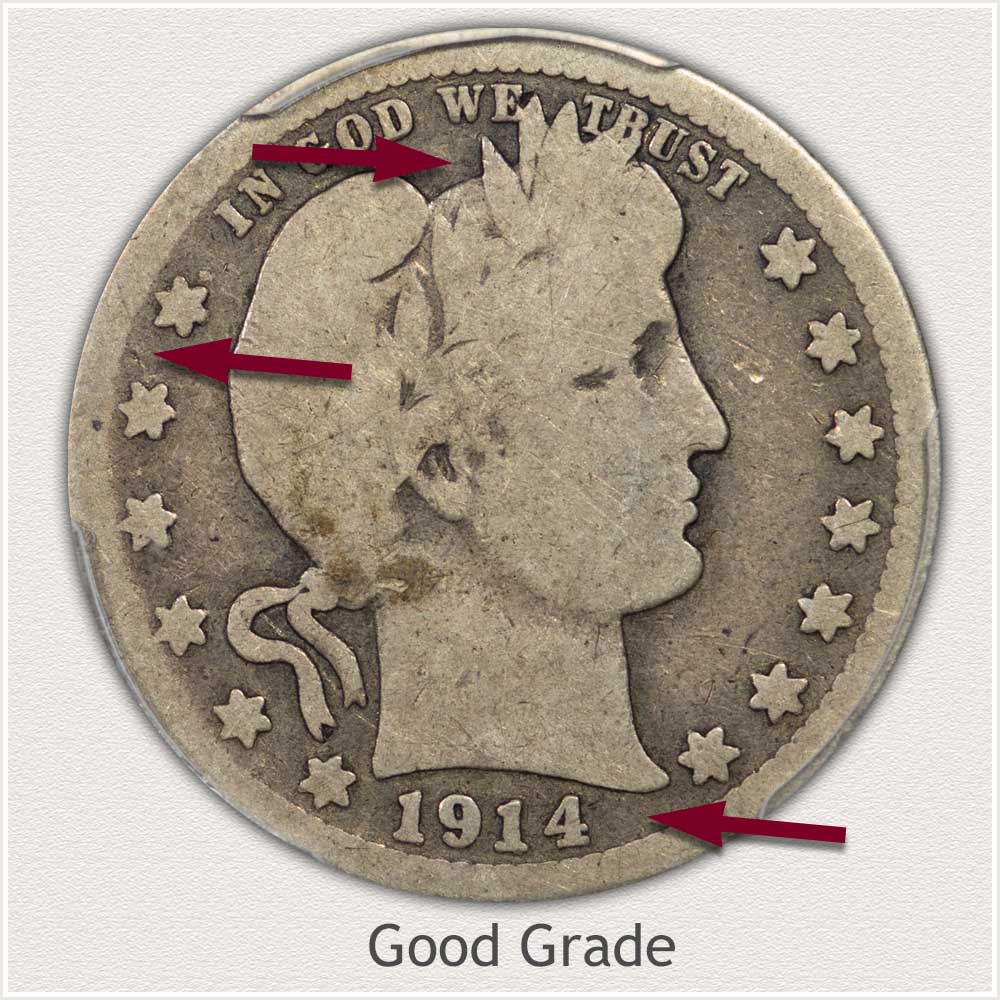
Good Grade: Viewing the example coin, it falls into the solid Good grade range due to three main characteristics. First, the portrait must remain completely outlined and prominent from the field. Liberty's portrait no longer has any of its fine details due to the effects of wear, leaving only an outline. Second, a defined rim and stars are still visible. Lastly, the date is well defined and strong.
The Good grade is defined by the amount of wear flattening the main devices to a flat surface. Looking at the upper portion of the portrait, all of the leaf edges are distinct; there is no blending with the rim or the lettering. In addition, a full inner edge to the rim is visible and well defined remaining separate of the star points. A nice feature that frames the portrait are the bold stars and rim.
In addition, the date, which is important, is separated from the rim. Any additional wear lowers the rim, which then starts to blend with the date, stars, and features of Liberty. Any merging of elements to the rim reduces its appeal to collectors. Overall, a nice example of a vintage Barber quarter.
How to Video: Grading Barber Quarters
When grading a Barber quarter, there are important areas on the coin to consider. Wear and surface condition is judged and determined by these features. Both the video and descriptions provide specific details regarding grading.
Video, Images and Descriptions | Grading Barber Quarters
Step 3: | Special Qualities | Historical Low Production
Demand Plus Low Supple | 1913 Quarters Reflect Strong Values
Often rarity and high values are strongly contributed to initial production of particular date and mint combinations. 1913 Barber quarters are keenly studied by collectors, they became the lowest totally yearly mintage of the series that ended in 1916.
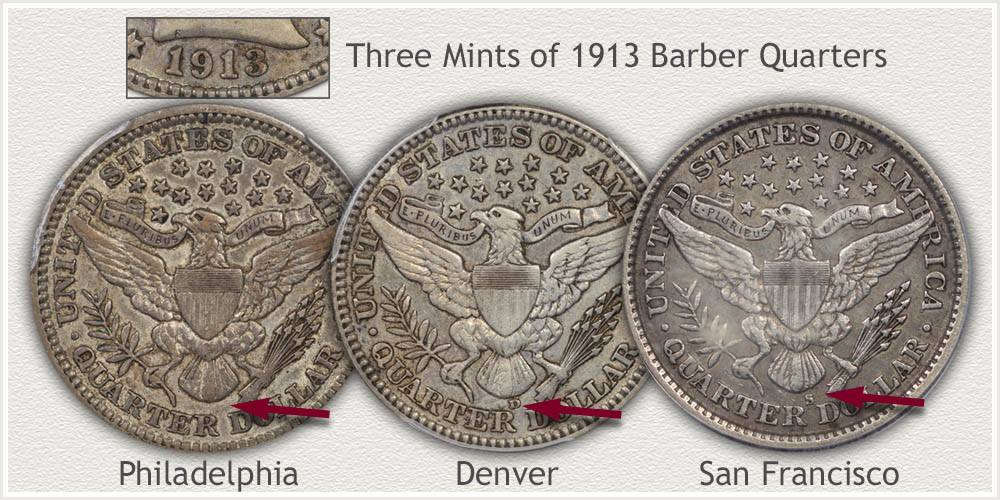
Just over 1.9 million 1913 dated quarters were produced by three mints. Denver contributed by far the greatest amount, 1,4 million quarters.
Becoming a key, rare date and mint issue, San Francisco minted an historic low of 40,000 quarters. A very scarce coin 1913 quarters bearing the "S" mintmark are highly valued in all states of condition.
Philadelphia mint, normally contributing millions of quarters per year, struck what became the lowest yearly total from the mint; 484,000 quarters.
Awareness of these low initial supplies is now reflected in strong premiums. Collectors realize the difficulty of finding eye appealing examples.
Leading in 1913 value, the San Francisco issue is second only to the 1901 San Francisco coin in the top value position of the entire Barber series. 1913-S (San Francisco) is firmly considered a major key and rare coin.
1913 quarters struck by the Philadelphia mint are also a challenge to obtain in high collectible condition.
Collections are typically formed around themes. Complete Date and Mint collections are searching for all varieties of 1913 quarters. Date only collections need to represent the year 1913; putting pressure on the "common" Denver variety to fill the position.
With demand by a range of collecting needs, 1913 is a special quality year of the Barber quarter series. Strong, stable value.
References
U.S. Mint. 1902 U.S. Mint Annual Report.
https://nnp.wustl.edu/library/book/321
U.S. Mint. 1914 U.S. Mint Annual Report
https://nnp.wustl.edu/library/book/514127
Coin Values | CoinStudy Articles
Date by Date
In Depth Barber Quarter Values
1892 to 1916
Barber Quarter Value | Many Scarce Dates
1913 is just one of twenty-five dates to the Barber quarter design series. Each is valued separately on the full value chart. Steps identifying date, mint, and condition lead to finding an accurate place on the chart.
Old Coin Value | Identify Your Coin
Of the many U.S. coin designs, match your coin to images to identify correct series. Links lead to specific value charts and steps to follow in determining how much old quarters are worth.
Print the Coin Values Worksheet
Record accurate descriptions of Barber quarters with values. Your collection becomes identified and organized.
Popular Coin Series | U.S. Quarters
Realizing the popularity of Barber quarters helps identify the strength of the market for these coins. Coin series are charted according to numbers of serious collectors active in registry programs listing their collections. Quarter dollars, as a denomination, are ranked second to the dollar denomination.
Coin Grading Services | Professional Review of Your Coins
The series of coin, date and mint are evident on coins. Identifying the Grade of a coin is a skill of judging condition. When the potential of value is entering the hundred-dollar range and above, professional grading is often a good option. Subtle points to condition are expertly assessed. The top two services are reviewed.
★Coin Values Discovery finds 1913 Quarter Value and...
All old coin values. Images are used to follow a step by step method when determining how much U.S. coinage is worth.
